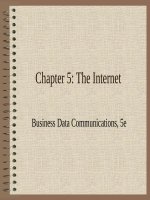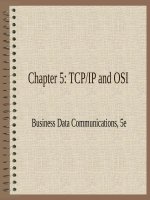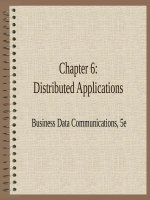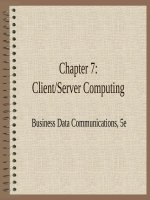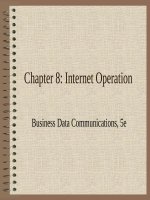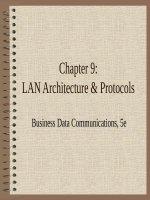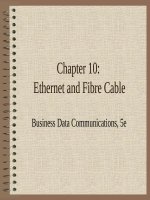Business data communications 4e chapter 11
Bạn đang xem bản rút gọn của tài liệu. Xem và tải ngay bản đầy đủ của tài liệu tại đây (627.25 KB, 38 trang )
Chapter 11:
Approaches to Networking
Business Data Communications, 4e
LANs, WANs, and MANs
✘ Ownership
✘ WANs can be either public or private
✘ LANs are usually privately owned
✘ Capacity
✘ LANs are usually higher capacity, to carry greater internal
communications load
✘ Coverage
✘ LANs are typically limited to a single location
✘ WANs interconnect locations
✘ MANs occupy a middle ground
Comparison of Networking Options
Types of WANs
✘ Circuit-switched
✘ Packet-switched
Circuit-Switching
✘ Definition: Communication in which a dedicated
communications path is established between two
devices through one or more intermediate switching
nodes
✘ Dominant in both voice and data communications
today
✘ e.g. PSTN is a circuit-switched network
✘ Relatively inefficient (100% dedication even without
100% utilization)
Circuit-Switching Stages
✘ Circuit establishment
✘ Transfer of information
✘ point-to-point from endpoints to node
✘ internal switching/multiplexing among nodes
✘ Circuit disconnect
Circuit Establishment
✘ Station requests connection from node
✘ Node determines best route, sends message to next
link
✘ Each subsequent node continues the establishment
of a path
✘ Once nodes have established connection, test
message is sent to determine if receiver is ready/able
to accept message
Information Transfer
✘ Point-to-point transfer from source to node
✘ Internal switching and multiplexed transfer
from node to node
✘ Point-to-point transfer from node to receiver
✘ Usually a full-duplex connection throughout
Circuit Disconnect
✘ When transfer is complete, one station
initiates termination
✘ Signals must be propagated to all nodes used
in transit in order to free up resources
Public Switched Telephone Network
(PSTN)
✘ Subscribers
✘ Local loop
✘ Connects subscriber to
local telco exchange
✘ Exchanges
✘ Telco switching centers
✘ Also known as end office
✘ >19,000 in US
✘ Trunks
✘ Connections between
exchanges
✘ Carry multiple voice
circuits using FDM or
synchronous TDM
✘ Managed by IXCs
(inter-exchange carriers)
Digital Circuit-Switching Node
Circuit Switching Node:
Digital Switch
✘ Provides transparent signal path between any
pair of attached devices
✘ Typically full-duplex
Circuit-Switching Node:
Network Interface
✘ Provides hardware and functions to connect
digital devices to switch
✘ Analog devices can be connected if interface
includes CODEC functions
✘ Typically full-duplex
Circuit-Switching Node:
Control Unit
✘ Establishes on-demand connections
✘ Maintains connection while needed
✘ Breaks down connection on completion
Blocking/Nonblocking Networks
✘ Blocking: network is unable to connect two
stations because all possible paths are already
in use
✘ Nonblocking: permits all possible connection
requests because any two stations can be
connected
Switching Techniques
✘ Space-Division Switching
✘ Developed for analog
environment, but has been
carried over into digital
communication
✘ Requires separate physical
paths for each signal
connection
✘ Uses metallic or semiconductor
“gates”
✘ Time-Division Switching
✘ Used in digital transmission
✘ Utilizes multiplexing to place
all signals onto a common
transmission path
✘ Bus must have higher data
rate than individual I/O lines
Routing in Circuit-Switched
Networks
✘ Requires balancing efficiency and resiliency
✘ Traditional circuit-switched model is
hierarchical, sometimes supplemented with peerto-peer trunks
✘ Newer circuit-switched networks are
dynamically routed: all nodes are peer-to-peer,
making routing more complex
Alternate Routing
✘ Possible routes between two end offices are
predefined
✘ Originating switch selects the best route for each
call
✘ Routing paths can be fixed (1 route) or dynamic
(multiple routes, selected based on current and
historical traffic)
Control Signaling
✘ Manage the establishment, maintenance, and
termination of signal paths
✘ Includes signaling from subscriber to network, and
signals within network
✘ In-channel signaling uses the same channel for
control signals and calls
✘ Common-channel signaling uses independent
channels for controls (SS7)
ISDN
✘ 1st generation: narrowband ISDN
✘ Basic Rate Interface (BRI)
✘ two 64Kbps bearer channels + 16Kbps data channel (2B+D) =
144 Kbps
✘ circuit-switched
✘ 2nd generation: broadband ISDN (B-ISDN)
✘ Primary Rate Interface (PRI)
✘ twenty-three 64Kbps bearer channels + 64 data channel
(23B+D) = 1.536 Mbps
✘ packet-switched network
✘ development effort led to ATM/cell relay
Past Criticism of ISDN
✘ “Innovations Subscribers Don’t Need” , “It Still
Doesn’t Network” , “It Still Does Nothing”
✘ Why so much criticism?
✘ overhyping of services before delivery
✘ high price of equipment
✘ delay in implementing infrastructure
✘ incompatibility between providers' equipment.
✘ Didn’t live up to early promises
ISDN Principles
✘ Support of voice and nonvoice using limited set of standard
facilities
✘ Support for switched and nonswitched applications
✘ Reliance on 64kbps connections
✘ Intelligence in the networks
✘ Layered protocol architecture (can be mapped onto OSI
model)
✘ Variety of configurations
ISDN User Interface
✘ “Pipe” to user’s premises has fixed capacity
✘ Standard physical interface can be used for voice,
data, etc
✘ Use of the pipe can be a variable mix of voice
and data, up to the capacity
✘ User can be charged based on use rather than time
ISDN Network Architecture
✘ Physical path from user to office
✘ subscriber loop, aka local loop
✘ full-duplex
✘ primarily twisted pair, but fiber use growing
✘ Central office connecting subscriber loops
✘ B channels: 64kbps
✘ D channels: 16 or 64kbps
✘ H channels: 384, 1536, or 1920 kbps
ISDN B Channel
✘ Basic user channel (aka “bearer channel”)
✘ Can carry digital voice, data, or mixture
✘ Mixed data must have same destination
✘ Four kinds of connections possible
✘ Circuit-switched
✘ Packet-switched
✘ Frame mode
✘ Semipermanent



